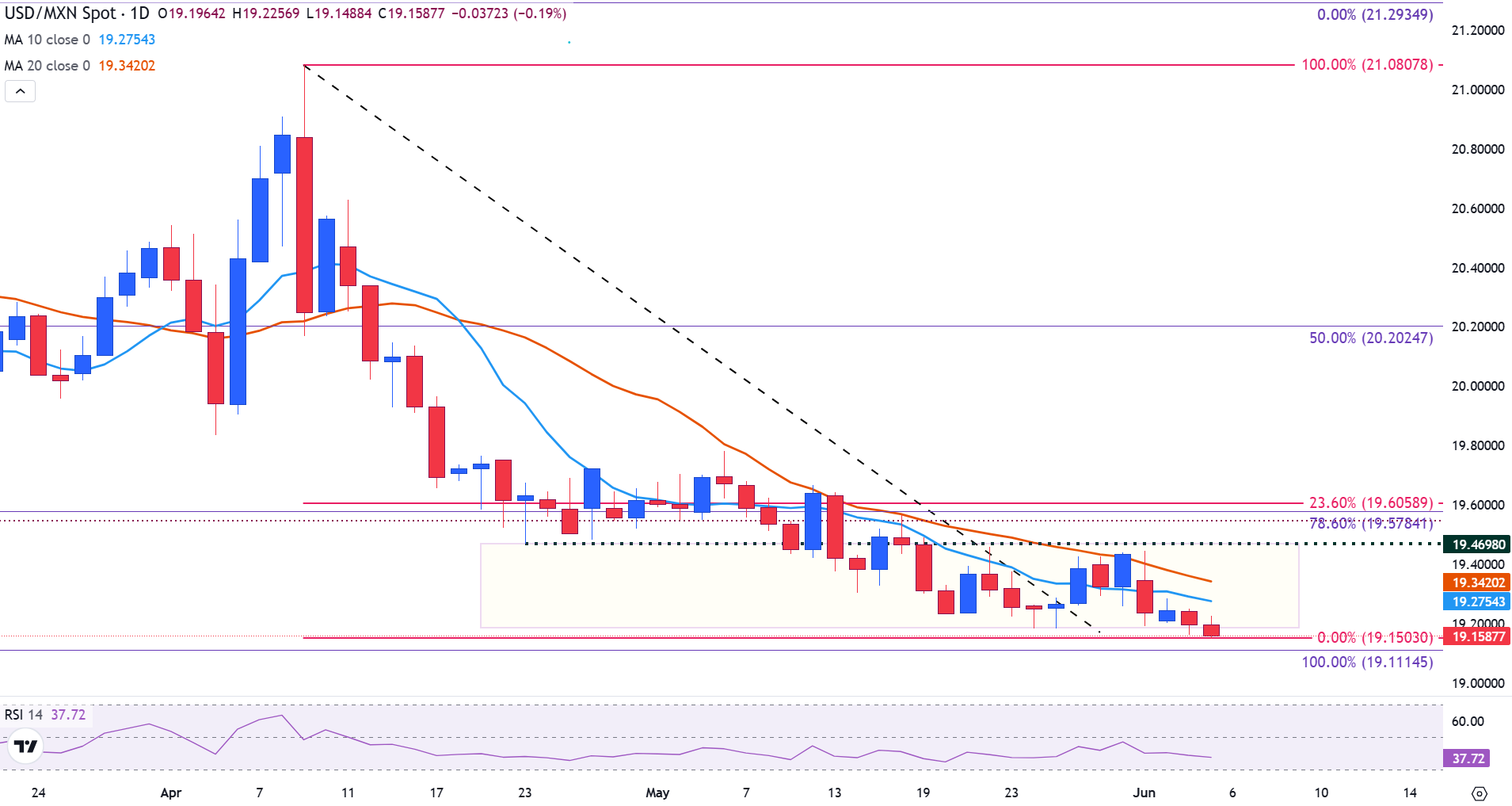Created
: 2025.06.06














![]() 2025.06.06 04:40
2025.06.06 04:40
The Mexican Peso (MXN) is on track to extend its winning streak for a second consecutive session against the US Dollar (USD) on Thursday.
At the time of writing, USD/MXN is trading near the new yearly lows, around 19.15, as market participants shift their focus to the upcoming US Nonfarm Payrolls (NFP) report, due Friday, which could provide fresh direction for the pair.
During the European session, risk appetite remained fragile, but confirmation of a productive phone call between US President Donald Trump and Chinese President Xi Jinping helped ease some market jitters, lifting overall sentiment.
For the United States, attention now turns to Friday's release of the US Nonfarm Payrolls report, a key labor market indicator that could influence the Federal Reserve's policy outlook. Analysts expect the US economy to have added 130,000 jobs in May, marking a slowdown from the 177,000 gain in April. The Unemployment Rate is expected to hold steady at 4.2%. Mexican Peso daily digest: USD/MXN monitors US-Mexican relations, US labour market conditions
Price action on the USD/MXN daily chart continued to reinforce the broader bearish structure, as the pair posted another red candlestick, closing near the critical support zone between 19.15 and 19.20.
This decline keeps the price firmly below both the 10-day Simple Moving Average (SMA) at 19.28 and the 20-day SMA at 19.34. The 78.6% Fibonacci retracement level at 19.57, derived from the broader October-February rally, now acts as a key resistance level, further capping any recovery attempts.
The Relative Strength Index (RSI) near 38 signals bearish momentum, although the indicator has yet to reach oversold conditions, suggesting potential for further downside.
USD/MXN daily chart

From here, the bearish scenario would involve a decisive break below the 19.15 support, potentially exposing the next downside target at the October low of 19.11. A failure to hold above this level could accelerate selling pressure. On the other hand, the bullish scenario would require a sustained recovery above 19.28 (10-day SMA) and 19.34 (20-day SMA), followed by a breakout above the 19.60 resistance, which aligns with the 23.6% retracement of the same October-February move.
The Mexican Peso (MXN) is the most traded currency among its Latin American peers. Its value is broadly determined by the performance of the Mexican economy, the country's central bank's policy, the amount of foreign investment in the country and even the levels of remittances sent by Mexicans who live abroad, particularly in the United States. Geopolitical trends can also move MXN: for example, the process of nearshoring - or the decision by some firms to relocate manufacturing capacity and supply chains closer to their home countries - is also seen as a catalyst for the Mexican currency as the country is considered a key manufacturing hub in the American continent. Another catalyst for MXN is Oil prices as Mexico is a key exporter of the commodity.
The main objective of Mexico's central bank, also known as Banxico, is to maintain inflation at low and stable levels (at or close to its target of 3%, the midpoint in a tolerance band of between 2% and 4%). To this end, the bank sets an appropriate level of interest rates. When inflation is too high, Banxico will attempt to tame it by raising interest rates, making it more expensive for households and businesses to borrow money, thus cooling demand and the overall economy. Higher interest rates are generally positive for the Mexican Peso (MXN) as they lead to higher yields, making the country a more attractive place for investors. On the contrary, lower interest rates tend to weaken MXN.
Macroeconomic data releases are key to assess the state of the economy and can have an impact on the Mexican Peso (MXN) valuation. A strong Mexican economy, based on high economic growth, low unemployment and high confidence is good for MXN. Not only does it attract more foreign investment but it may encourage the Bank of Mexico (Banxico) to increase interest rates, particularly if this strength comes together with elevated inflation. However, if economic data is weak, MXN is likely to depreciate.
As an emerging-market currency, the Mexican Peso (MXN) tends to strive during risk-on periods, or when investors perceive that broader market risks are low and thus are eager to engage with investments that carry a higher risk. Conversely, MXN tends to weaken at times of market turbulence or economic uncertainty as investors tend to sell higher-risk assets and flee to the more-stable safe havens.
![]()
Created
: 2025.06.06
![]()
Last updated
: 2025.06.06

FXStreet is a forex information website, delivering market analysis and news articles 24/7.
It features a number of articles contributed by well-known analysts, in addition to the ones by its editorial team.
Founded in 2000 by Francesc Riverola, a Spanish economist, it has grown to become a world-renowned information website.
We hope you find this article useful. Any comments or suggestions will be greatly appreciated.
We are also looking for writers with extensive experience in forex and crypto to join us.
please contact us at [email protected].
Disclaimer:
All information and content provided on this website is provided for informational purposes only and is not intended to solicit any investment. Although all efforts are made in order to ensure that the information is correct, no guarantee is provided for the accuracy of any content on this website. Any decision made shall be the responsibility of the investor and Myforex does not take any responsibility whatsoever regarding the use of any information provided herein.
The content provided on this website belongs to Myforex and, where stated, the relevant licensors. All rights are reserved by Myforex and the relevant licensors, and no content of this website, whether in full or in part, shall be copied or displayed elsewhere without the explicit written permission of the relevant copyright holder. If you wish to use any part of the content provided on this website, please ensure that you contact Myforex.
Myforex uses cookies to improve the convenience and functionality of this website. This website may include cookies not only by us but also by third parties (advertisers, log analysts, etc.) for the purpose of tracking the activities of users. Cookie policy